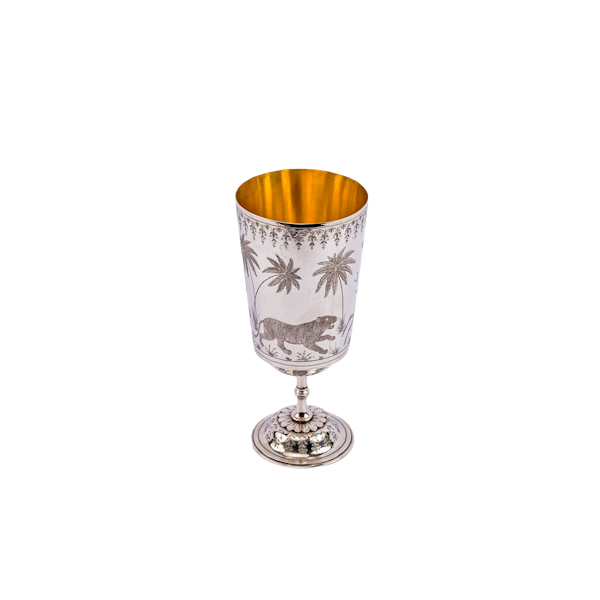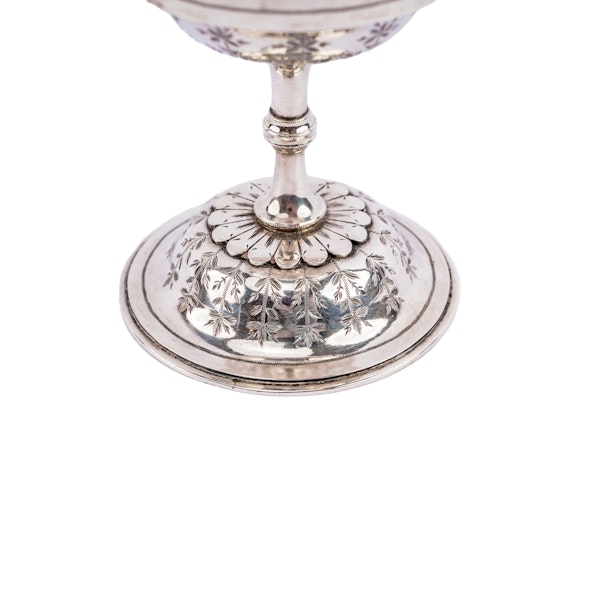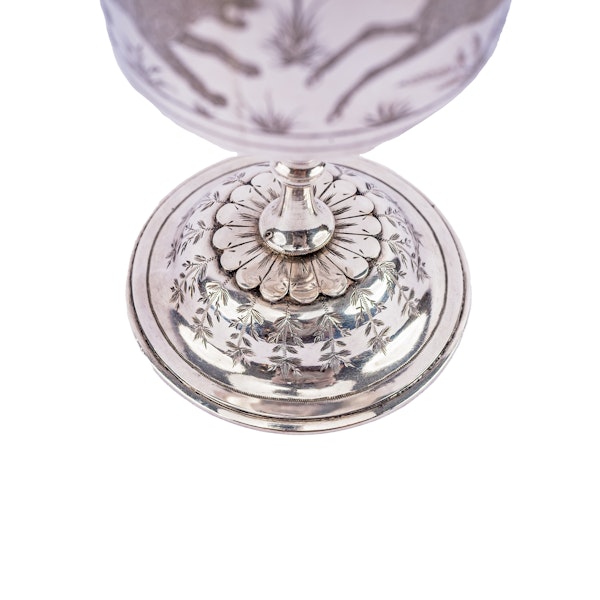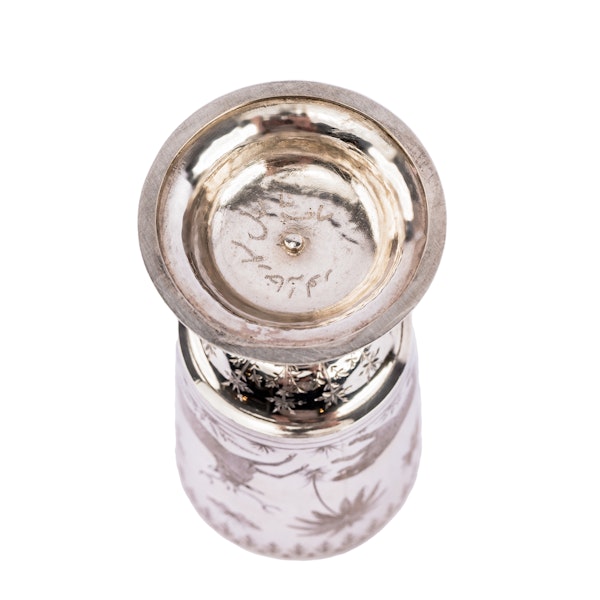Antique Indian Silver Goblet, Museum Quality, Signed Panna Lal, Alwar (Ulwar), India - circa 1883
Antique Indian Silver Goblet, Museum Quality, Signed Panna Lal, Alwar (Ulwar), India - circa 1883
£3,850.00
Description
This rare, beautiful and extremely fine silver goblet was made in Alwar, India around 1880 and is fully signed in Urdu to the underside of the foot by the renowned Alwar engraver, Panna Lal. The signature translates as ‘made by Panna Lal in Ulwar’ (now known as Alwar). Panna Lal was one of the greatest exponents of engraved Alwar silver, an original and distinctive way of ornamenting silverware with fine engraving which developed in the Alwar area around 1880.
The condition of this goblet is exemplary, with no discernible signs of use or wear. We can only surmise that it has been carefully wrapped and stored since being purchased, around 140 years ago!
The bowl of this goblet is bucket shaped and has an unused shield shaped cartouche. Under a pendant border of stylised foliage and flowers, the two principal scenes either side of the cartouche, feature a tiger framed by palm trees and a stag with a butterfly. Below these are tufts of plants and grasses. The bowl of the goblet is supported by a mounded foot with an inwardly tapering stem which meets an elegant, stepped knop halfway up the stem. From this point, the stem tapers outwards until it meets the ‘basin’ which supports the bucket shaped bowl of the goblet, which mirrors the mound of the foot, creating balance, as does the similar ornamentation of both these elements. The crispness of the ornamentation is as Wilkinson and Hendley describe below.
According to Wynyard Wilkinson, Alwar, in North-East Rajasthan, was never subjugated by the Moguls, which enabled the area’s traditional Indian arts and crafts to flourish with little Persian influence, when compared to those in the areas which were ruled by Moguls.
For generations, Alwar had a mint, for producing coinage, which was a major employer in the area until its closure in 1880. After it closed, former employees were allowed to use the old mint buildings as a base and workshop. They established a ‘loose co-operative’ there with the intention of using their expertise to create ‘art products’ for the European market. Although the co-operative itself did not last long it was undoubtedly the starting point for the development of Alwar’s unique regional silverware style i.e., the ornamenting of silver objects of European form with fine naturalistic engravings of Indian animals, plants, trees, birds and insects, of which this goblet is a superb example.
Panna Lal and Nand Kishore attended the new co-operative. They had both been engravers at the mint and had studied together at the Civil Engineering College at Rurki and for a time Kishore also taught at that College. Kishore was also a trained silversmith, an inventor and an artist. These two very talented individuals had many years of experience in working with precious metals and are believed to have been the driving forces in developing this new Alwar style. They were certainly the greatest exponents. Together, they collaborated on the design and execution of a finely engraved silver tea service which was exhibited at the Jeypore Exhibition of 1883, to great acclaim. By the time the Jeypore Exhibition took place, Kishore had left Alwar, after accepting a job at the Jeypore Court, whilst Lal remained in Alwar.
Outline drawings illustrating the scenes engraved on the tea service can be found in Hendley’s Volume 1 of ‘Memorials of the Jeypore Exhibition 1883’ at Plate XXVII and this image was reprinted by Wilkinson on page 182 and can also be viewed below. Although, the images are not the same as those featured on this goblet, there are clearly great similarities. Volume 2 of Hendley’s ‘Memorials’ contains a photograph of four silver tumblers from the Exhibition, a chased silver tumbler from Bikanir, a silver and enamel tumbler and a silver niello tumbler, from Kashmir, and an engraved silver tumbler from Alwar, which features an elephant. Unfortunately, the craftsman of the latter is not named but it is likely Panna Lal, as there are clear similarities of style and subject matter.
In Volume I of ‘Memorials of the Jeypore Exhibition 1883’, Hendley devotes much attention to the new Alwar engraved style, and his comments make it clear that he preferred the work of Panna Lal to that of Nand Kishore, who he criticised for an over-use of engine turning. Discussing a different teapot signed by Panna Lal, Wilkinson states “The body of the teapot carries the finely rendered animals and butterflies that are the hallmark of the style of Panna Lal. ….. The technique of light chiselling, with shallow but precise incisions, is seen to advantage on the highly polished surface. ….. Especially noteworthy is the attention given to the delineation of the texture of the fur, hide, or feathers, of the creature depicted. Slender palm trees and fern-like foliage are equally delicately rendered.”
Thomas Holbein Hendley (1847 - 1917) was a British medical officer and author on Indian art. He served as an officer in the Indian Medical Service from 1869 until his retirement in 1903. Hendley was the founder of the Quarterly Journal of Indian Art. In 1886, he helped establish the Jaipur Museum (now Albert Hall Museum). In the 1880s, Hendley wrote several books on Indian Art including the four volume ‘Memorials of the Jeypore Exhibition 1883’ in which he wrote: -
“A new and most interesting style of engraved silver plate has been developed at Ulwar (Alwar). The fur and markings of the animals are imitated with great thoughtfulness and the vegetation is also marvellously natural. The articles adorned are generally of European form, such as tea sets, snuff boxes or card cases; and no doubt, the natural treatment of the subjects, and a certain unsuitability of such fine engraving on silver for these purposes, are wrong in principle; yet we cannot but admire the skill and truthfulness.
Panna Lal and others are the chief artists at Ulwar.”
Despite the attention and admiration, the Alwar engraved style was relatively short lived; its popularity waning about five years after the style emerged and within ten years of its emergence the style was abandoned. Wilkinson explains that this decline in popularity was probably because the silver objects they produced did not withstand any form of usage. “The high purity of the silver used rendered the surfaces softer and thus easier to engrave with the fine detail that made Alwar decoration so special, but it also rendered the objects unsuitable for use. As soon as the silver article was polished, or subjected to normal wear and tear, the decoration would begin to lose its fine detail, thus spoiling the wonderful, natural effect ….. Nevertheless, the decoration is both charming and of the highest quality.”
| item details | |
|---|---|
| Origin | Asian |
| Period | 19th Century |
| Style | Other |
| Condition | Excellent |
| Dimensions | Weight:232 grams |
| Diameter | Height:16.0 cm Maximum Width: 7.3 cm |
Product REF: 10063
















